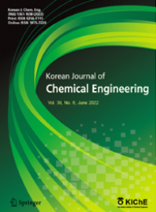Overall
- Language
- English
- Conflict of Interest
- In relation to this article, we declare that there is no conflict of interest.
- Publication history
-
Received June 10, 2023
Accepted November 21, 2023
-
 This is an Open-Access article distributed under the terms of the Creative Commons Attribution Non-Commercial License (http://creativecommons.org/licenses/bync/3.0) which permits
unrestricted non-commercial use, distribution, and reproduction in any medium, provided the original work is properly cited.
This is an Open-Access article distributed under the terms of the Creative Commons Attribution Non-Commercial License (http://creativecommons.org/licenses/bync/3.0) which permits
unrestricted non-commercial use, distribution, and reproduction in any medium, provided the original work is properly cited.
Most Cited
Enhanced Oil Yield by Catalytic Pyrolysis of Thermoplastics Using Cost-Eff ective Spent FCC and BaCO 3 and Its Valorization to Gasoline and Diesel Grade Fuel via Fractionation
https://doi.org/10.1007/s11814-024-00041-4
Abstract
In this work, the fossil fuel-based thermoplastics, i.e., low-density polyethylene (LDPE), polypropylene (PP), and polystyrene
(PS) were pyrolyzed at 450 °C, 500 °C, and 550 °C thermally and catalytically to enhance the oil yield and further enrichment
via fractionation. In the catalytic process, spent FCC (sFCC) and low-cost BaCO 3 with 10 wt% loading were used in a semibatch
quartz reactor. Thermogravimetric analysis (TGA) and derivative thermogravimetric analysis (DTG) were carried out
at 10 °C/min for LDPE, PP, and PS to analyze the degradation behavior. Among the used catalysts, the sFCC gives higher
oil yield than BaCO 3 under identical conditions. The LDPE oil yield obtained was 55.5% and 35.7% for sFCC and BaCO 3 ,
respectively. Similar trends were observed for PP (80.0% and 70.0%) and PS (98.0% and 95.0%). Gas chromatography–mass
spectrometry (GC–MS) analysis revealed that product oil composition obtained for sFCC-catalyzed pyrolysis process was
majorly in the gasoline range (C 6 –C 12 ) whereas for BaCO 3 enabled pyrolysis in the diesel range (C 13 –C 18 ). Plausible acid
and base-catalyzed reaction mechanism and product formation are discussed for catalytic pyrolysis of PP. Fractionation of
pyrolysis oil was performed at 150 °C, 250 °C, and 350 °C and physiochemical properties as well as the visual inspection of
resulting fractions were carried out as per ASTM methods. Overall, this work represents the utilization of sFCC and low-cost
BaCO 3 catalyst to convert plastic waste into promising fuel.

